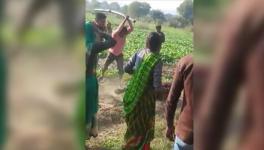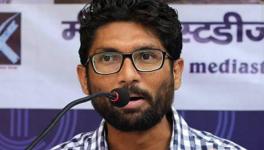“Karya Portrays the Tragedy of Dalit Lives — their Exploitation by Landowners & Ascetics…”
On the third day after the death of Bangaravva, a solemn procession making its way towards the graveyard encounters a strange obstacle. The division between castes and communities comes to the fore as the panchayat struggles to pronounce justice. Translated into English by Susheela Punitha, Aravind Malagatti’s Karya unfurls the politics and power embedded within a dalit community.
Writer Githa Hariharan speaks with Malagatti and Punitha on writing and translating the novella.
Githa Hariharan (GH): The exploitation of dalit groups by ‘ascetics’ is a very sharp section in Karya. Please comment on how such exploitation is ‘institutionalised’ by the custom of revering ‘ascetics’ as the vessels of wisdom and so authority?
Aravind Malagatti (AM): In the novel, Bangaravva’s death is just an excuse; it is a narrative strategy. Through this strategy, the novel tries to portray the tragic lives of the dalit community. The landowners exploit the community financially, and the ascetics exploit them mentally. The ascetics sow seeds of ignorance in the minds of dalits, making independent thought difficult, even impossible. The landowners use the same ignorance to drain the dalits financially. Both landowners and ascetics have long made a living out of exploiting dalits, deprived as they are of education, and even a sense of self-worth.
GH: Karya brings out, subtly, the division not only between ‘upper caste’ and ‘lower caste’ but also the numerous hierarchies among those who are not upper caste. Is there a difference in these hierarchies between rural and urban settings? Has this changed at all with the building of movement against caste?
AM: Similar to the divisions among the ‘upper castes’, there are numerous divisions among the ‘lower castes’ as depicted in the novel.
There may appear to be no differences in these divisions between rural and urban settings, but only if we look at it superficially. If we look more carefully, the contrast is visible. I could say rural life is one of imitation, while urban life is more pretentious. But life in both circumstances is dependent on caste. This dependence seeps through economic, social and spiritual dimensions.
The movement against caste has definitely weakened the roots of casteism, but its impact is mostly on the literate and socially aware pockets among the population. The penetration has not been as effective in rural areas when compared to urban areas. Human relations have been strengthened with organising and agitation. But inter-caste marriages are more frequent among the upper strata than in the lower ones.
The movement against caste has definitely weakened the roots of casteism, but its impact is mostly on the literate and socially aware pockets among the population.
GH: Karya is filled with detail about ‘custom’ — much of which could be described by a rationalist as superstition that oppresses or exploits people. What is apparent in Karya is also the fluidity of this custom — no one really seems to know what the requirements are, or how people are supposed to fulfil them. Is this a reading that was intended?
AM: Your reading of the novel is with the right perspective. The rituals described in the novel in emphatic detail to reach the reader’s consciousness. There isn’t a declaration of protest in the novel. The main intention is to make the reader feel dissatisfied. I believe this such dissatisfaction acts as a driver for change in the society. The usual pattern of protest in literary work satisfies the reader without giving the reader the impetus to think through the reality. Of course there are instances of conflict in the novel. For instance, Dasharatha regrows his moustache despite upper caste objection; and Malappa elopes with the Gowda’s wife Padmavati.
GH: While the novel never loses sight of the conditions of dalit lives, it is also very natural in its description of rural lives and people, including in its use of humour and irony. Some of the humour seems to be entangled with the tragedy of their lives — the repeated bouts with toddy and alms, for example. Also, does this tragedy lie in the self-image the dalit group in the novel has of itself?
AM: Even though social life in the novel is tragic, individual lives are filled with humour, including sarcasm and irony. The novel indicates that there is life beyond rituals and traditions. In the midst of the community’s journey with death rituals, the woman Akkamma finds her lost buffalo swimming in the pond. She hands over the ritual pitcher to someone and rushes across to catch her buffalo. Her act symbolises the fact that there is more to life than rituals; that life is much more important than the rituals.
The usual pattern of protest in literary work satisfies the reader without giving the reader the impetus to think through the reality.
GH: The ending is open and unexpected, as if to say there is no resolution to this situation in real life. Would you comment on the ending — the body buried with such difficulty turning up above the ground?
AM: So many complications arise in the novel because of a lapse in the ritual of carrying the ‘kullaggi’ — the wind blows and the man carrying the sacred ritual fire drops in on the ground. But at the end, what do they do when the corpse is dug out of its resting place? This basic question they are confronted with shows the meaninglessness of the rituals they struggled to follow to bury the body. The complicated rituals for burying leading to pointless deaths of many more — that is the irony. This story is a never ending one. Why has the corpse been dug up? Was it done under the influence of the ascetic? Was it done because people are superstitious? Because they are incapable of independent thought? Or because they lack education? Is it a conspiracy by Shanta Gowda? Or is all without purpose? These questions themselves make up the answer.
Also read | An excerpt from Karya
GH: One of the points you mention in the translator’s note is how several languages leak into the novel and mingle in the text. The reader notices this clearly with ‘kala numbri’. Is this confluence of Kannada, Marathi and Urdu a phenomenon close to state borders? How did you address this as a translator into English?
Susheela Punitha (SP): This confluence of Kannada, Marathi and Urdu is peculiar to the regional variety of Kannada spoken in North Karnataka. In Vasudeva’s Family and “Worlds Within Worlds”, Vaidehi uses a local variety of Mangaluru Kannada which is a mix of Kannada and Tulu. In “Ibadat”, Bolwar Mahammad Kunhi uses a blend of Malayalam and Urdu expressions, typical of the Kannada spoken in the Kasargod region along the Kerala border.
Yes, I do remember being flummoxed by ‘kala numbri’ in Karya. It is a compound word that blends Urdu and English to make an expression used in the regional variety of Kannada spoken in North Karnataka. ‘Kala numbri’, Malagatti explained to me, refers to Section 144 of the Criminal Procedure Code. It is a kala or black number because it prohibits people from gathering on the streets during a curfew. But even more confusing was ‘dus numbri’ in his story, “Ayyappa of the Ahimsa Slippers”. ‘Dus numbri,’ of course, means ‘number ten’. But this bit of lexical information does not help us to grasp the contextual significance. It has to be subtly worked into the translation. ‘Dus numbri’ in the story refers to the supplier of beef; dus, meaning ten, is the highest number allotted to grade meats like fish, chicken, mutton, beef… And so, I retained dus numbri for its local flavour and added a sentence to bring out its meaning: ‘Only one lives on, Hussain saab, the dus numbri. Only that beef-seller knows the whole story.’ Such an interpolation is not an intrusion since it is more organic than structural, drawing the reader’s attention to the subtle connection between Hussain saab the butcher, and Ayyappa the cobbler.
It is a tight-rope walk to find a fine balance between being faithful to the flavour of the text and being concerned with its intelligibility to the reader.
And it is not only the regional varieties of Kannada that pose a problem. Characters in some stories become bilingual even as we do as we speak. In Bolwar’s “Ibadat” and Banu Mustaaq’s “Not a Woman”, they switch from Urdu to Kannada with ease. In Na D’Souza’s stories with Christian themes, such as “God’s Labourer” or “The Day the Crucifix Came Home”, the characters shift between Konkani and Kannada. And then, there are cultural nuances of Sanskrit in U R Ananthamurthy’s novel Bharathipura, and of the Alwar saints in S. Diwakar’s “Kraurya” that I have retitled “Epiphany” in the English translation. In fact, transferring the ambience of Tamil culture in the setting of “Krauya” earned me a compliment when a Professor at a conference said, ‘I thought you translated only from Kannada. I didn’t know you could translate so well from Tamil too.’ I had to tell him that Diwakar’s “Kraurya” was a story in Kannada! The compliment was as much to the writer as to the translator.
I have occasionally resorted to retention and interpolation, taking care to see that I use the strategy only to explicate the intention in the story. In fact, my very first attempt at such a clarification in U R Ananthamurthy’s Bharathipura was thanks to my editor, Mini Krishnan. ‘What is avu?’ she asked since she does not know Kannada. And while I was explaining to her the sophistication in Kannada grammar that has ‘avu’ for non-human plural and ‘avaru’ for human plural, while English has ‘they’ for both, I became aware of the implications of referring to people as ‘avu’, in terms of attitude. And so, I brought in the cultural significance with an interpolation: ‘“They came,” he said to himself, as if they were a herd of cattle.’ And I explained the need for the interpolation in my Translator’s Note. Paul Sharrad titled his review of the translation, ‘What is avu?’
It is indeed a tight-rope walk to find a fine balance between being faithful to the flavour of the text and being concerned with its intelligibility to the reader. The spontaneity of retelling a Kannada novel in English is stalled whenever I noticed gaps in meaning, significance and flavour, and I close them by choosing from both the languages to make the third language of the translated text to meet the specific demands of the novel.
GH: There are points in the novel when an apparently casual comment holds an entire history. One example: ‘No one asked them why the tea was black; they lived dark lives anyway.’ This is powerful in translation and makes me curious about the original, and other such sharp thrusts we may miss in the translation. Would you comment on the language and craft of the novel?
SP: There is a similar sharp thrust in the reference to ‘mangagala upavasa’ in the last paragraph of the chapter, “Broken Pot and Leaking Issues”. It is a description of the mourners ‘fasting like monkeys.’ It is seemingly a casual comment on a way of life. But a literal translation of the expression would miss the point. I had to rewrite to make it, ‘…some people fasted like monkeys who fast when they have nothing to eat, anyway.’ Note the undercurrent of irony: just as monkeys fast only when they get nothing to eat, these people fasted because they had no food anyway. This is an example of the gut-wrenching humour typical of Malagatti’s style, not only here but in his short stories as well.
While Malagatti’s enigmatic style makes the implications all the more forceful, I had to use interpolations as scaffolding to interpret culture-specific rituals that point towards their deeper significance in the context. For instance, in the last chapter, I had to elaborate Channappa’s musings on the rites connected with the fifth day after death to highlight the magnitude of the desecration that follows. Malagatti’s narration is cryptic: ‘Tomorrow makes five days since Bangaravva died,’ Channappa grumbled to himself.’ Readers familiar with the rituals following death in the Machegara community will understand the implications of Channappa’s grumbling. But I had to use a lengthy interpolation describing the fifth-day ritual in detail — here we have a community eager that ‘Bangaravva’s face should be embossed on silver as a hiriyamukha; she’s now a forebearer.’ Of course, I could not have done this if Malagatti had not given me a detailed description of the ritual.
I had to use interpolations as scaffolding to interpret culture-specific rituals that point towards their deeper significance in the context.
After editing the text, Mini Krishnan wondered about juxtaposing Karya with U R Ananthamurthy’s Samskara since the themes are similar with death rites going awry. And I recalled an insight I had gained when I interviewed U R Ananthamurthy in 2012 for the Oxford Perennials edition of Samskara. He had explained the significance of the rituals on the days following the cremation and said that the brahmin community refused to cremate Naranappa because they did not want to accept him as a pithru.
The contrast in the treatment of the situation in the two novels is obvious. But the incipient irony in the similarity has to be noted: Both writers have made the caste identity in the men so overwhelming that they cannot think beyond the stringent demands of the death rites leading to the acceptance of the dead person as a progenitor. Only the women, Chandri in Samskara, and Akkavva and Padmavathi in Karya, have been given a sense of agency to act as individuals who are capable of looking beyond the dead-end situation to find a breakthrough for themselves.
This was indeed a scary venture but I am glad I went through it. It has reinforced my belief that, though the going can be tough, collaboration with the writer and my editor can help making the venture of translation easier and more effective.
Aravind Malagatti is an eminent Kannada poet and writer. He was the recipient of the prestigious Ambedkar Fellowship Award from the government of Karnataka. His autobiography, Government Brahmana, the first dalit autobiography in Kannada, won the Karnataka Sahitya Akademi Award.
Susheela Punitha has translated several books from Kannada into English. In 2015, she received the Sahitya Akademi Translation Award, for her translation of UR Ananthamurthy’s novel Bharathipura.
Githa Hariharan has written many novels, short fiction and essays over the last three decades. Her novel The Thousand Faces of Night won the Commonwealth Writers Prize for Best First Book in 1993. Her most recent novel is I Have Become the Tide.
Courtesy: Indian Cultural Forum
Get the latest reports & analysis with people's perspective on Protests, movements & deep analytical videos, discussions of the current affairs in your Telegram app. Subscribe to NewsClick's Telegram channel & get Real-Time updates on stories, as they get published on our website.

























